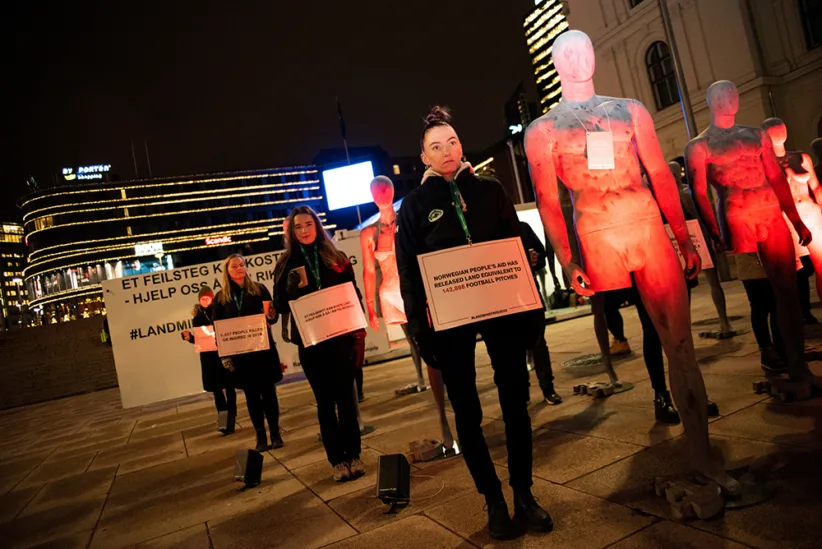
Adopted on 18 September 1997, the Anti-Personnel Mine Ban Convention (APMBC) entered into force as binding international law on 1 March 1999. Its implementation has encompassed sustained action to rid the world of millions upon millions of emplaced anti-personnel mines. Demining programmes over the past 20 years in some 90 countries worldwide have cleared a total of at least 2,880 square kilometres of mined area, with the destruction of more than 4.6 million anti-personnel mines.
Tens of thousands of lives have undoubtedly been saved as a direct result of mine action, and demining’s broader contribution to development has been huge. This herculean effort been supported by more than US$10 billion of combined national funding and international aid.
Antipersonnel landmines are explosive devices designed to be detonated by the presence, proximity, or contact of a person. They do not discriminate between combatants and civilians. Antipersonnel landmines have been used by most armed forces in the world, and for decades they have claimed victims around the globe on a daily basis. In addition, emplaced landmines deprive families and communities of land that could be put to productive use such as agriculture. They maintain a sense of insecurity long after conflicts end, delay peace processes, and impede development.
The Antipersonnel Mine Ban Treaty (MBT), which was adopted in 1997 and entered into force in 1999, is a milestone achievement in the field of humanitarian disarmament. It prohibits the use, production, transfer, and stockpiling of antipersonnel mines. It also requires that each State Party clear antipersonnel mine contamination on its territory within ten years (Article 5), and destroy stockpiles within four years (Article 4). Support for victims of antipersonnel mines is also required by the treaty.
More than 80% of all states in the world are States Parties to the MBT. It also has a great normative effect on those states that are not yet party to it. Thanks to the treaty, landmine use has dramatically dropped, as has global production and trade. Additionally, tens of millions of antipersonnel mines have been destroyed, large areas of contaminated land have been cleared and returned to communities for safe use, and the number of new recorded casualties has significantly reduced since the 1990s.
More than 30 states and other areas have completed clearance of antipersonnel mines on their territories since the MBT entered into force. Landmines are nevertheless still a threat in almost 60 states and other areas. NPA remains concerned over areas where the clearance of mine contamination is slow and over the number of states seeking to extend their Article 5 deadlines to complete their clearance obligations. The good news is that for the majority of affected states and other areas, completion of clearance can be accomplished in a matter of just a few years if up-to-date land release methodologies are napplied and the requisite political will is mobilized.
NPA calls on all states and stakeholders to ensure full implementation of the MBT, and more specifically of the treaty’s clearance obligations. Strong political will is the key to reach this objective.
Concretely, this means that NPA calls for the following:
- All states should ratify/accede to the MBT if not already a State Party.
- Contaminated states should establish an ambitious plan for completion of their clearance obligations under Article 5 of the treaty; secure resources; and build necessary institutions and capacities for timely implementation.
- Contaminated states should establish policies and laws that enable the application of sound land release methodology as a major opportunity for improved efficiency and more expedient treaty compliance.
- Donor states should provide sustained, or for some countries, increased levels of funding for landmine survey and clearance, while making clear calls on recipient governments to facilitate the application of good land release methodology. As more and more of the countries with light and medium contamination are ticked off the list, sustained levels of funding will ensure that all countries can reach completion.
NPA’s advocacy in support of our call is an integral and continuous component of all of our mine clearance operations. NPA also pursues a regional approach, carrying out advocacy in neighbouring states where there is no NPA presence. Such regional advocacy can often be done from existing operations with minimal additional effort.
On a global level, NPA’s advocacy on landmines takes place in partnership with likeminded operational NGOs and as an active member of the governance board of the International Campaign to Ban Landmines (ICBL) (www.icbl.org) global civil society coalition working for a world free of antipersonnel landmines. NPA is also a key contributor of research and analysis to the Landmine Monitor, the de facto monitoring regime for
the implementation of the MBT.
Finally, NPA participates in relevant forums that aim to enhance the quality and coordination of mine action, such as the Meetings of States Parties to the MBT and the annual International Meeting of Mine Action National Programme Directors and UN Advisors.
Antipersonell Mines - a definition
According to the Mine Ban Treaty, an antipersonnel mine “means a mine designed to be exploded by the presence, proximity or contact of a person and that will incapacitate, injure or kill one or more persons."
Made of plastic, metal or other materials, they contain explosives and sometimes pieces of metal or other objects meant to cause additional injury. They can be activated by direct pressure from above, by pressure put on a wire or filament attached to a pull switch, or even simply by the proximity of a person within a predetermined distance. (Source: International Campaign to Ban Landmines)
